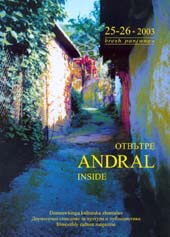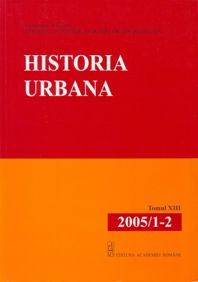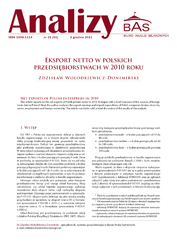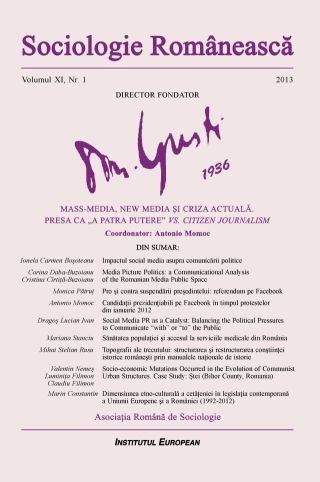






Keywords: archaeological evidence; medieval towns; Moldavia; Wallachia; Transylvania; Lower Danube
More...

Keywords: Poland; enterprises; exports;
This article reports on the net exports of Polish private sector in 2010. It begins with a brief overview of the sources of foreign trade data in Poland. Next, the author analyses the export earnings and import expenditure of Polish companies broken down by sector, employment and foreign ownership. The article concludes with a brief discussion of the results of the analysis.
More...

Keywords: social media; online reputation management; political communication
Raed Arafat’s resignation from his position of Secretary of State within the Ministry of Health on January 10th 2012 ignited the political crisis that took place in January-February 2012 and led to a series of street protests, which culminated when the Emil Boc Government resigned on February 9th 2012. The newness of these street movements that happened in Romania’s large cities consisted in the online mobilization of the protesters. The citizens showed online their solidarity with Raed Arafat, the medic who opposed the Government’s intentions to change the Sanitary System Law. According to the Secretary of State, the reform would have liberalized the health services, which would have affected the low income population, as well as the Public Emergency Ambulance Service. The social networks users organized in online communities of supporters, and the members of these groups settled and communicated online the time and meeting place where they gathered to shout anti-governmental and anti-presidential slogans every evening. The Romanian politicians, especially the potential candidates for the 2014 presidential elections, have not remained indifferent. Most of them reacted in an effort to improve their image and their level of trust among the protesters, who have organized themselves through social media. Using the content analysis method applied on the politicians’ official Facebook accounts, this article presents the quick reactions, and the image and communication strategies that the presidential candidates resorted to during the protests started on the social networks in January 2012.
More...
Keywords: social media; communication; politics; public relations
Sensuous public relations practices, the activity through which dialogue and communication is shaped, transmitted and disseminated. In its different ways, PR conceptualizes societal evolution as inter-woven with social practices; and those practices, in turn, shape its activity. PR arises among distinctive social groups and institutions, between a political figure and its constituency, on the basis, and as a response to given conditions and relationships. It is in the presence of these conditions Romanian PR practitioners have to handle and respond to the conditions of existence. We engage in quantitative and qualitative research Romanian PR practitioners so as to understand the impact of social media in Romanian PR political campaigns. We seek to place PR practitioners within a new society conceived as a complex expressive entity with new demands out of its political figures, and in consequence, in need of new PR instruments and solutions. There are, of course, some unresolved problems and some new threats for both Romanian PR practitioners and Romanian political figures, not least of which is the unevenness of dialogue between public and political figure. We alert to the assumption about the channels of communication with the young community, apparently disengaged from civic participation and disillusioned by political figures.
More...
Keywords: political communication; social media; referendum; 2012; Traian Băsescu
Facebook has proved to be an efficient means of political communication between citizens and politicians. On this virtual stage, political actors display their competence, consolidate their fame, mobilize their volunteers and attack their political opponents, encourage donations and debate some sensitive issues of the society. Citizens have the chance to get informed, to organize and to mobilize themselves for different causes or candidates, to participate in different events or elections campaigns. Our study will analyze the use of Facebook during the election campaign for the impeachment referendum (July 29, 2012). The analysis will focus on the posts made both by the pro-Băsescu citizens and by those that are against. The research questions addressed will focus on: a) the types of information posted by both opponent groups; b) the degree in which the Facebook accounts are used for acclaims, attacks or defenses; c) the time span during the election campaign in which „the dialogue” between the two groups gets more intense; d) the degree of interactivity between those who post the information and their „friends”. The research methods are functional analysis and content analysis. The two opponent groups sent their messages by the use of photographic images, verbal texts and advertising images. They used more attacks than acclaims, and had an intense activity during the middle and the end of the campaign. Their Facebook pages were interactive allowing the posting of appreciations, comments and the distribution of the materials posted.
More...
Keywords: collective memory; periodization of history; Romanian history; sociology of memory; politics of memory
Starting from the assumption that the social management of historical time is a powerful tool in the political definition of reality, this paper analyzes how the history of the Romanian people has been periodized through the course of time. The central argument states that the partitioning system used to periodize the past harbors a hidden agenda, or a particular ideological „implicature”, that can be brought to light by analyzing the temporal watersheds selected as defining moments in the history of that community. The paper analyzes the social logic of periodization operating within the Romania national history textbooks, revealing how socio-political conditions determine the temporal structuring of the past. Moreover, it shows how social change, and especially the change of the socio-political regime, leads to a revertebration of the past’s symbolic backbone. Dramatic social and political change results in reconfiguring the formal structure of the collective consciousness concerning the past, within which specific events of Romanian history acquire their meaning. In conclusion, the study shows that, although resorting to a system of periodization is indeed a cognitive prerequisite for understanding the past, the reality of the past does not come with an already-there articular structure, so that „carving the (past’s) reality at its joints”, as Plato put it, is not a possibility.
More...


Keywords: indicators; causes; disadvantaged social cathegories
This article shows some of the contrasts among the Romanian quality of health services and that from European Community. Through its medical practices and critical health state of its population, Romania seems deeply dissociated from European Union realities in this respect. Since two decades, the Romanian public health system is situated at the tail-end of the European systems in what concerns social prevention, care for population’s health, application of some sanitary public programmes and performances of the medical services providing. And all these after about twenty years of health services reform, and multiplying of public health care spending of five times. The article includes two chapters focused on some health and demographic indicators, and on the existing difficulties in accessing public health services encountered by various disadvantaged categories of population – with an accent on some new research data concerning the access of the Rroma ethnic group to the public health services. There are used data published by Eurostat, but also from the national and territorial health statistics.
More...

Keywords: democratisation of political communication; social media; net-politique
The paper „The impact of social media on political communication” aims to emphasize the changes brought by new technologies, via social media, to political communication, as an unprecedented transformation of the communication between a politician and the ordinary potential elector. Following the rise of the internet and the success of social networks, political communication adapted to the web structure by means of the online interaction of the two actors in the public scene. Social media is a relatively new concept, used rather than defined in the specialised literature. Therefore, after a brief definition and a diachronic presentation of the concept, we intend to describe the new features of political communication used by politicians by means of new communication techniques, providing examples wherever possible. New media, a form of mass communication, was a constant topic of our concern, and, therefore, approaching the social media phenomenon is nothing but a natural consequence of our previous studies. The article is structured into two chapters, as follows: The first chapter deals with the social media phenomenon and the changes it brought to political communication. The second chapter concerns the social media – political communication which will highlight the reviving of political communication through social media, leading us to assert that, through social media, political communication tends to become – in Dominique Boullier’s terms – net-politique (internet politics). The bibliographic references we made use of in describing this theme come from the Anglofrancophone research area, but also from the Romanian specialised literature.
More...
Keywords: ethnicity; citizenship; transborder; cosmopolitanism; Europe; Romania
My article is conceived as a comparative assessment of the implications that the European Union enlargement in 2007 has entailed upon the ethno-national belongingness among Romanian nationality and ethnic minorities in Romania. The cultural identity of ethnic and linguistic communities is currently related to the statute of European Union citizenship, as established by the article 8 of the Maastricht Treaty of European Union (1992). In such socio-economic and legislative framework, the anthropological theorizing of ethnicity and “cosmopolitanism”, alongside that of the “human rights” and the “national minorities”, actually approximates the ethno-cultural dimension of the European and national citizenship, in the historical continuity and development of the European national states, as well as within their institutional structuring, once they have adhered to a European community. The equivalence and communication between the terminology of European and national legislation (with its specialized juridical principles) endorse the European conceptualization of national citizenship, and, at the same time, the national intelligibility of European citizenship. To exemplify, the official language of Romanian state is also one of the official languages of Europen Union, which is the same as the recognition by the Constitution of Romania of the minorities’ right to use their maternal languages in justice. Similarly, the ethnic, cultural, linguistic, and religious identity compose the “configuration” of ethnonationality in the Framework Convention for the Protection of National Minorities, in the Constitution of Romania, and in the draft Statute of National Minorities in Romania as well.
More...
Keywords: media; media public space; communications lifecycle; communication analysis
Our paper implies a comparative analysis of the Romanian media public space in the years 2011 and 2012, by pointing out the process, actors and themes of the communication. We inquire whether we have real communication autonomy in the public space and how public space’ actors relate with journalists and politicians. We are interested in understanding how citizens and opinion leaders succeed to communicate and state their position, but also what are the themes they choose. The methodology is content analysis, with which we investigated the content of the messages within the media public space in Romania, the actors and the mechanisms of the communication. Also, our study implies a communication analysis of the public space, as it uses a content analysis method specific to public relations, communications lifecycle, developed by David Michaelson and Toni L. Griffin, in order to analyse the efficiency of the communication. Our study shows that there is a strong connection between the themes communicated by public space’s actors and the topics spread out by the media. Moreover, we see that media is dominated by political messages, which have an important influence on the message content of the public space’ actors, who don’t seem to succeed in imposing new themes, or to generate a real debate on the issue at matter. Finally, our paper reconsiders the debate on the public space and the media public space, for a better understanding of their dynamics and communication mechanisms.
More...